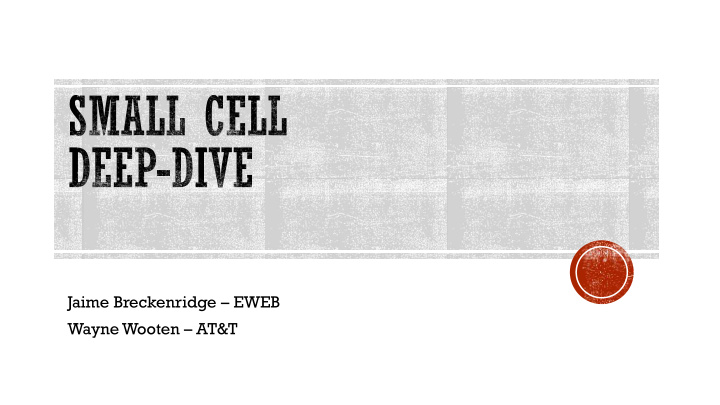



Jaime Breckenridge – EWEB Wayne Wooten – AT&T
CONSUMER AND BUSINESS DEMAND FOR WIRELESS DATA IS ON THE RISE
Ways to Increase Wireless Network Capacity Deploy more spectrum + • Spectrum is not readily available Improve spectrum efficiency • Repurposing existing spectrum • e.g., 3G carves for LTE Add more macro (cell sites) cells • Optimal for low concentration areas Add more small cells • Offloads surrounding macro sites
▪ EWEB established in 1908 ▪ Largest publicly owned municipal utility in Oregon ▪ Provide Water and Electric ▪ 61,000 water meters ▪ 93,000 electric meters ▪ Over 18,000 T&D poles ▪ Additional 5,000 CTL poles within territory ▪ Generation Facilities / Trading Floor
“Coming together is a beginning; keeping together is progress; working together is success.” ~Henry Ford
Small cells can densify our network to meet customer demand 6
Multiple layers of RAN Engineering analysis go into geographical selection of node deployment, but it boils down to two triggers: ▪ PDSCH SINR - Signal to Noise ratio (Measurement of Quality/Throughput) ▪ HARP Analysis – Data Traffic (Number of Users per Square Kilometer) SINR(Before) SINR(After) Data Traffic Density – Aerial View Data Traffic Density – Map View
A new network architecture is needed Small cells can Small cells are a flexible, targeted network solutions that cover a radius up to 1200+ feet & can be readily deployed to specific locations, including: densify our ▪ Where customers are prone to experience connectivity issues network to meet ▪ Heavily populated areas that need more network capacity Areas that can’t effectively be served by a traditional macro cell ▪ customer This allows us to provide a better LTE experience today while also allowing us to prepare for the technologies of the future such as 5G, smart cities and new developments in the Internet of Things demand (IoT)..) 8 This photo depicts an example of what a small cell could look like. Actual size, shape and dimensions may vary by location.
Spreadsheet with poles of ❑ interest and what type of antenna installation at those sites. Does it meet EWEB’s standard? ❑
Internal review ❑ External review ❑
▪ EWEB provides feedback on tentative poles ▪ Viable ▪ Alternate ▪ Non-EWEB owned pole ▪ Does not meet standard ▪ AT&T prepares Site Packet ▪ AT&T submits EWEB Application & Site Packet
▪ EWEB processes Application (within 2 target) ▪ Engineering begins analysis and design (target 45 days) ▪ Completed Design, Make-Ready Costs and Site Lease Agreement (SLA) are sent to AT&T ▪ EWEB submits City ROW Permit ▪ AT&T executes SLA and pays Make- Ready costs
▪ Pre-construction Meeting ▪ Pole-top or Mid-pole ▪ EWEB construction ▪ AT&T construction ▪ Post inspection ▪ Energize site
QUESTIONS?
Recommend
More recommend